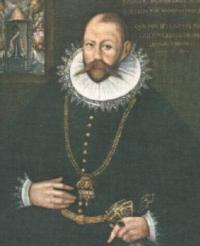Tycho Brahe
Danish astronomer, b. 14 December 1546 (Knudstrup, Denmark), d. 24 October 1601 (Prague).
 Tycho Brahe was the son of a privy councillor and governor of Hälsingborg castle but was abducted in his early years by his childless uncle, who raised him, eventually with parental consent, in his castle at Tolstrup. He also financed Tycho's education at the University of Copenhagen, where Tycho studied law during 1559 - 1562.
Tycho Brahe was the son of a privy councillor and governor of Hälsingborg castle but was abducted in his early years by his childless uncle, who raised him, eventually with parental consent, in his castle at Tolstrup. He also financed Tycho's education at the University of Copenhagen, where Tycho studied law during 1559 - 1562.
The fact that a total solar eclipse predicted for 21 August, 1560 occurred at the predicted time impressed the young student immensely, and Tycho began to augment his daytime studies of law with nightly studies of the stars. In this he received the help of the professor of mathematics and others, who gave him Ptolemy's Almagest, the only book on astronomy available at the time, and assisted in the construction of instruments.
Brahe continued his studies during 1562 - 1565 in Leipzig, Germany, where in 1563 he observed a conjunction of Jupiter and Saturn and noted that the Copernican tables were several days wrong in their prediction of this event. He decided to collect accurate astronomical observations and produce accurate tables.
After travelling through Europe for several years and inheriting his father's and uncle's estates Tycho settled in Denmark and built a small observatory where, on 11 November 1572, he witnessed the birth of a supernova. By careful observation he proved that it was outside the realm of the moon, a fact not believed possible at a time when the realm of the fixed stars was supposed to be immutable. His publication De nova stella ("About a new star") in 1573 made him known throughout Europe.
In 1576 King Frederick II, who wanted to keep Tycho Brahe in Denmark, granted him title to land and offered financial support to build a better observatory with laboratories. Brahe worked in Denmark until the king's death in 1588. During the following years his situation became difficult - his often unreasonable demands for support angered the new King Christian IV, the church did not forgive him his Copernican ideas, and he had fallen out with the nobility in 1573 through marriage with a peasant's daughter - and Brahe left in 1597, eventually taking the position of imperial mathematician of the Holy Roman Empire in Prague under Emperor Rudolf II. He died in Prague in 1601.
With very basic instrumentation and mostly with the naked eye Tycho Brahe assembled the most comprehensive data set on the stars that existed in Europe. His list of 777 stars formed the basis for Kepler's work, his successor in Prague. His memory is kept alive in science as one of the great astronomers of the late Renaissance.
Reference
Eggen, O. J. (1995) Tycho Brahe. Encyclopaedia Britannica 15th ed.

Quadrans muralis sive Tichonicus
A view of Tycho Brahe's observatory with a description of the mural quadrant for measurement of the Sun's position. In the accompanying text Brahe explains how an observer positioned at F views the Sun through the window in the wall on the left and calls out the passage of the Sun through the meridian defined by the quadrant. An observed then takes note of the time on the clock, which shows hours, minutes and seconds, and a scribe records the result. Many more instruments can be seen in the background.
From Tychonis Brahe Astronomiæ Instauratæ Mechanica (1598). Impressum Wandesburgi, Hamburg.
Facsimile edition (1969): Impression Anastaltique Culture et Civilization, Bruxelles.
home
 Tycho Brahe was the son of a privy councillor and governor of Hälsingborg castle but was abducted in his early years by his childless uncle, who raised him, eventually with parental consent, in his castle at Tolstrup. He also financed Tycho's education at the University of Copenhagen, where Tycho studied law during 1559 - 1562.
Tycho Brahe was the son of a privy councillor and governor of Hälsingborg castle but was abducted in his early years by his childless uncle, who raised him, eventually with parental consent, in his castle at Tolstrup. He also financed Tycho's education at the University of Copenhagen, where Tycho studied law during 1559 - 1562.